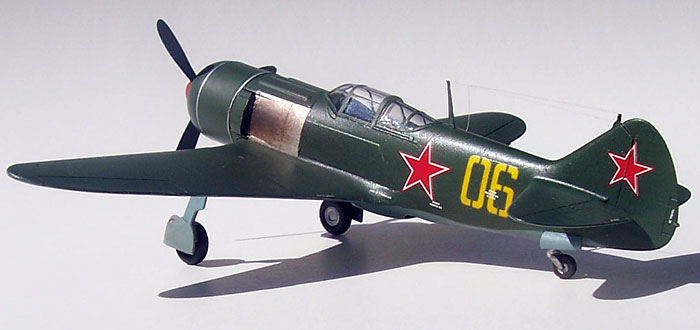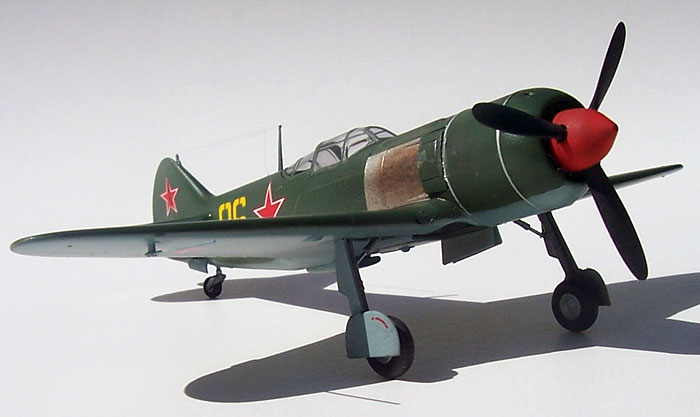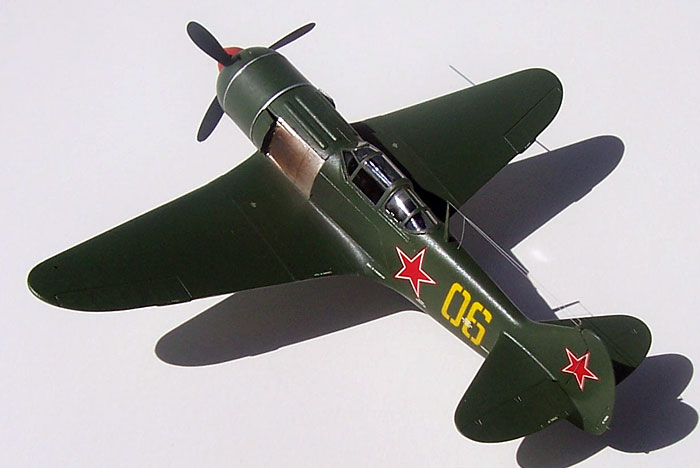|
Eduard's
1/72 scale
Lavochkin La-7
by Mark Davies
|
 |
|
Lavochkin La-7 |

Eduard's 1/72 scale Lavochkin La-7 is available online from
Squadron.com
Lavochkin’s rather overweight and indifferent
in-line engined LaGG 3 gave way to a much improved radial engined La-5,
which in turn became a simple but very effective fighter in its final
La-5FN from. The lack of a reliable radial engine offering more power
than the Ahs-82 FN engine used by the La-5FN meant that any improvement
in performance would have to be obtained through weight saving and
aerodynamic refinements. These improvements were prototyped with the
La-5 ‘206’, and most flowed through to production La-7’s. In this
respect the La-7 can be viewed as a refined La-5FN, rather than a new
design.
The La-7 was one of the superlative fighters of late WW2. It exceeded
the performance of its Bf 109 & Fw 190 adversaries by useful margins at
the low to medium altitudes where the Russian front air-war was fought.
In addition it offered rugged reliability during its almost constant use
from forward airfields. Various versions were developed late in the war
and shortly after, including armament variations, high altitude
developments and even a version fitted with a rocket motor in the tail.
Lavochkin’s last piston-engined fighters, the La-9 and La-11, were in
many respects metal-winged developments of the La-5 & La-7 line, seeing
service early in the cold war with several nations.
I have not built Eduard kits previously, and was
impressed upon opening this boxing of the three-cannon version (although
parts for the two-cannon version are still included). Parts appeared
well moulded and quite adequately detailed for the scale – Not as
comprehensive as say Tamiya’s 1/72 kits, but better than many purely
injected kits. I think that there is a “Profi-pack” boxing of the kit,
which amongst other things is bound to include Eduard photo-etch that
would enhance detail levels in the cockpit and elsewhere. This would not
be wasted as the cockpit canopy, of which open and closed versions are
provided, is commendably clear. An Eduard vinyl or plastic-type mask is
included for the canopy and wheels. A choice of four colour schemes was
provided, three Russian and one Czechoslovakian.

The parts fit proved to generally be very good, and at no stage could
any parts be considered as poor fitting. The instructions are clear and
easy to follow. The kit exhibits some limited run characteristics in so
far as the engineering does not ensure 100% automatically correct
fitting of things like undercarriage legs, although this was not a
problem as such. The canopy masks worked very well, but I found that the
small wheel masks lacked adhesion and I abandoned using them. As an
aside, I have found Eduard’s masks made of the same paper as Tamiya
masking tape to be superb (I used some supplied as part of a Czech
Master Resin kit). Eduard also provides a second set of wheel with
separate hubs, which at fist glance promised to make wheel and tyre
painting a breeze. However, the wheel hubs were undersized, so I chose
not to use them.
 I
decided to experiment with my paint finish and glossed some Model Master
enamels with a water-based wood varnish (guaranteed not to yellow)
thinned with isopropyl alcohol. I
decided to experiment with my paint finish and glossed some Model Master
enamels with a water-based wood varnish (guaranteed not to yellow)
thinned with isopropyl alcohol.
It worked fine, although it did lift in a couple of
places when I trimmed some Bare-metal Foil I used for the metal panels
on the fuselage sides behind the exhaust outlets.
Despite this, the pre-decal gloss finish was a good
one, and I found that Eduard’s decals were excellent, and presented no
problems.

My real problem came, when in a moment of over-confidence and madness, I
decided to double my experiment and try an artist’s matt lacquer spray
that was supposed to be suitable for both oil and acrylic paints. I’ve
used this successfully when decanted into my air-brush, but on this
occasion I blasted straight form the aerosol can, and left the model’s
surface too wet. This resulted in classic crazy cracking of the
underlying finish. I considered stripping the paint, but concluded
life’s too short. Besides, I needed to move onto to my next kit as it
will be my 100th completed 1/72 model plane to move into my display
cabinet. Accordingly I polished the crazing out with micromesh cloths,
resprayed in a couple of places and accepted a less than perfect result.
I have to say that I enjoyed what proved to be a very quick build over a
few nights. I have several other Eduard kits and look forward to
building them. If they are like the La-7 they should build every bit as
good as they look in their boxes.
Click the thumbnails below to view larger
images:
[../../photogallery/photo00000012/real.htm]
Model, Images and Text
Copyright © 2007 by
Mark Davies
Page Created 15 May, 2007
Last Updated
24 December, 2007
Back to
HyperScale Main Page |
Home
| What's New |
Features |
Gallery |
Reviews |
Reference |
Forum |